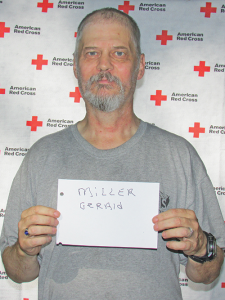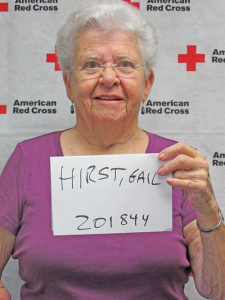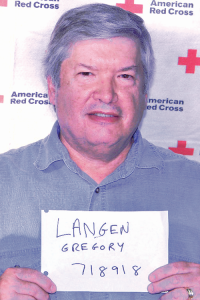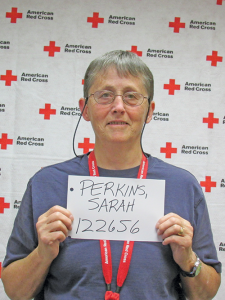Meet the Action Team Volunteers
They form the lifeblood of American Red Cross in the greater Rochester area and are always ready when disasters strike
By Lynette Loomis
What do a local house fire, tornado, mudslide and a hurricane have in common?
Ambulance corps, police and fire departments rush to control the scene and minimize loss of life. People’s lives are changed forever. Since 1881, when Clara Barton founded the American Red Cross, disaster action team (DAT) volunteers have provided relief to victims of local events, as well as national and international disasters.
In the greater Rochester community, DAT volunteers number in the hundreds and they come from all walks of life, differ in their life experience and range in age from teens to in the 80’s. Disaster responders serve in more than 30 positions within activity groups, available to deploy whenever needed.

DAT volunteer Jerry Miller, 60, was in the U.S. Army for 26 years and has been in emergency medical services for 25 years.
“I was in the military on 9/11 and was at the World Trade Center following its collapse. Our unit had been activated to help survivors and control the situation. The worst thing I have ever seen is 9/11. I was there for over two weeks, right on the pile. Red Cross volunteers were continually helping us with food and water. It made an impression on me. When my military career ended, my brother Francis talked me into volunteering for the Red Cross.”
Miller says there are some similarities between the military and Red Cross. Both have consistent training, rules and procedures to follow. The common protocol assures order and consistency in an emergency. “We each have been trained for our role and understand what is expected of us to be efficient and supportive in our roles in disaster relief. Of course there are times when you have to make a snap decision, but you draw on your training at all times,” he said.
“Because I am still employed, I am able to respond only to local disasters, most of which are house fires. The fire chiefs in Monroe, Ontario and Livingston counties can ask the fire dispatcher to call Red Cross. We have people dispatching DATs 24 hours a day. The team meets at Red Cross and we take the Duffy,” he added.
A bequest by Margaret Duffy, a longtime Red Cross volunteer, made the rolling RV office possible. It is specially equipped to provide two private interview rooms and store emergency supplies.
“Once we arrive on the scene, the team determines what type of help is needed. We listen, help devastated people get their thoughts together and call their family. The goal is to focus on their most immediate needs,” explains Miller. Red Cross provides vouchers for emergency housing, food and clothing. It also helps people find emergency housing for their pets who are also traumatized by fire. Some hotels will accept pets and some shelters can provide a safe place for 24-to-48 hours.
“I have seen the devastating effects of fires from loss of life to multiple- and single-family homes being completely demolished. When a life is lost, mental health counselors help people through the initial phases of shock and grief. It is never easy but we do our best to offer a sense of control and some comfort knowing that even complete strangers care about them.”
José A. Latalladi Jr., disaster program manager for the greater Rochester chapter of the Red Cross, encourages all people to consider volunteering.
Miller said volunteers can be trained in a combination of in-person and on-line training. “New volunteers can be paired with an experienced mentor to show them the ropes. And no matter what the disaster, you are always paired with someone; you are part of a team,” he said.
Hurricane ready

Eighty-year-old Gail Hirst has seen many changes since she and her husband began volunteering in 1999 when they lived in Florida. Seventeen years later and living in Rochester, she remains enthusiastic and committed to her work as a DAT volunteer. “In Florida, we always had an evacuation kit ready in a hard-sided brief case with our house and car keys, check books and some cash as well as the key to our safe deposit box,” she said. “Since moving to Rochester, I am not as concerned about a disaster I might experience but find great satisfaction helping people in other parts of the country. It is immensely satisfying to aid people at a most difficult time of their life.
“When we first started volunteering, we were trained to work in a variety of disaster settings and it could be anything affecting people from a flood or hurricane to an overturned tanker truck. Of course, there have been very touching moments. In Hurricane Sandy, I had the feeling that I wished I could do more for people. I worked in the office as the casework supervisor, sending people out to where they were needed and reviewing cases.
“In 9/11, we had a disaster service center in Tampa because many Florida residents were touched by someone residing in New York. We helped with casework and trying to help people get up north to a funeral or keeping them up-to-date on where they could find out about missing loved ones. Meeting their immediate needs was our function and our assistance was tailored to those needs.”
Hurricane Irene in 2011 was one of the most devastating hurricanes and hit the eastern U.S. Hirst acknowledges that technology came to their aid in the form of a global positioning system.
“With that kind of devastation, there are no street sign or landmarks left standing so it is disorienting even for the people who live there, much less Red Cross volunteers who come in from all over the country,” she said. “We even traveled into the wild to see if someone’s house was still standing and if people were truly missing.”
One of the benefits of DAT volunteer training is that training is the same in every chapter in the country.
“Because you all receive the same instruction, you can go anywhere and fit right in to form a team,” Hirst said. “Although we come from all walks of life, we are like-minded and know the procedures. And you are never alone. There is always support. I am in my 80’s and still communicate with Red Cross volunteers that are decades my junior with whom I have served.
“People don’t realize that everyone can make a difference. I can deploy and serve or work from home and assist people in other states because of the Internet and cell phones,” she said. “Even with a broken back, I was able to work from home. I would encourage anyone to consider being a DAT. There is no cost for the training and when you deploy, your transportation, meals and lodging are all covered by contributions.”
Paying it forward

Greg Langen, 65, started volunteering for the Red Cross almost four years ago after retiring from a career in social work.
“I see my work with the Red Cross as an opportunity to ‘get back to my roots,’ and help people in a direct and meaningful way, often during some of the worst times in their lives,” he said. His wife, Anita, concurs.
“Volunteering for the Red Cross has been good for Greg because it gives him a chance to use his social work and organizational skills from his career and continue to make a difference in the lives of people. I know he finds the work rewarding and that the people he assists really appreciate the help from the Red Cross,” she said.
Locally, much of what Langen does as a DAT volunteer is respond to house fires.
“In addition to having room to interview two families at a time in the Duffy, we also stock snacks, water, blankets, comfort kits, laundry kits, clothing, and last but not least, Mickey Mouse dolls donated by Disney to give to the kids. I’ll never forget the looks on the faces of the kids we helped who were burned out of their house last Christmas Eve. All their presents were destroyed as well as everything else they owned, but they lit up when we were able to give each of them a Mickey Mouse doll,” recalls Langen.
“Our main mission on a DAT call is to provide for the immediate needs of the fire victims. A fire scene is typically very chaotic, and the fire victims may feel overwhelmed by the emotional stress of their loss. Imagine that you lost your identification, all your medications, your food and clothes and everything else you own,” he said. “You have no idea where you are going to sleep tonight, where your next meal is coming from, or what you are going to wear tomorrow. Providing assurance to fire victims that you are there to help them deal with all of that is very helpful to them and rewarding for the volunteers.
“We can reach our health services nurse volunteers right from the Duffy who arrange for the replacement of all their medications. We can also bring in mental health services if needed by the clients — a very valuable service in the case of an injury or death. We can immediately provide food, clothing and transportation allowances, as well as lodging. In addition, our casework volunteers provide information and referral services in the days after the fire to help our clients get their lives back in order. After responding to a house fire, you know you have made a meaningful impact on the clients you have served, and always feel grateful that you were able to help.”
Langen says he is always amazed by the resilience of people. “Sometimes that is with the support of family and friends, and often is it because the Red Cross is there for them. Red Cross volunteers provide a human connection and a sense of community support during difficult times, things we all need when dealing with life’s most difficult challenges,” he said.
At a recent deployment in flood-stricken Texas, Langen reported his experience. “We were driving down a rural road that had just that day became accessible and noticed an elderly woman walking aimlessly in a nearby field. She was plodding around in circles for no apparent reason. We stopped and called out to her to see if she needed any help. It turns out she had Alzheimer’s disease and had wandered away from the car where her son had told her to stay while he checked on his house. Her confusion was exacerbated because the flooded area looked so different that she didn’t know where she was. We escorted her out of the field and reunited her with her son when he came back out to the road.
“I’m not sure whether we saved a life today, but we surely alleviated some suffering. This was a very rewarding day.”
Veteran of disasters

A Marine Corps veteran (1964-1969) and retiree from the National Technical Institute for the Deaf, Sarah Perkins has been deployed to 43 disasters. She began DAT work 11 years ago. Watching news footage of Hurricane Katrina touched Perkins.
“I sat in the safety of our home and thought that there has to be more I can do than write a check,” she said.
The local chapter of the Red Cross conducted a massive volunteer recruitment drive. She completed her paper work and was deployed to Louisiana as a life, safety and asset protection responder, and became a disaster responder.
Perkins explains how the two levels work.
“DAT volunteer work is the entry level work all volunteers experience. In addition to DAT service at the local level, we are each given the opportunity to select an activity group from more than 30 in which to serve,” she said. “We are given all the training needed, and are allowed to select whether we will serve with our region, within the state, the division, or nationally. Many of us choose to serve nationally, deploying as disaster responders on that level, and continue to work within DAT at the local level concurrently.”
“With such an urgent, large-scale disaster occurring, one of the things the team I was on did was to serve as our own internal security force. We monitored our own volunteers as workers, to make sure they were suitable and to double check background checks and to look after everyone’s safety,” explains Perkins. The first time she went, she stayed for 12 days but a mold-induced infection drove her back to Rochester for treatment. After recovering, she returned for another 18 days. “One of the important things we learn in our training is not to become a victim, no matter what the disaster,” she said.
One of her most touching moments, and there have been hundreds, was assessing the home of an elderly gentleman in the Binghamton flood in 2007 created by days of torrential rain. The mayor had asked the Red Cross to visit him. The man would not leave his dog Mickey. There are often more animals at risk in a disaster than places that can accommodate them and human families are loathe to leave the pet members of their family.
“His home was filled with mud and he had fans going but the smell of mold and mildew was unmistakable. We encouraged him to get the rugs cleaned immediately, or better yet remove them entirely, but his reason for not doing so brought tears to our eyes. His wife had passed away and the rug was the last thing for which she had carefully saved money,” she said. “As he relayed this to us, we could see the pain in his face. This rug was an important memory to him. To have it removed was almost like losing even more of his wife from his life. As we left, Mickey still was looking out the living room window for his mama to come home. That memory will be with me always.”
“I think it’s a real wake up call to realize that people’s possessions aren’t just ‘stuff’. They are the memories that shaped their lives and center them,” said Perkins. “We laugh in gratitude and relief when in the debris we can uncover something a person thought was lost. We might overturn some debris and there is a single picture or a piece of china. Having this small possession helps them hold onto a celebration and regain some control over their upturned life.”
Next to her tenure in the Marines, Perkins says her involvement with the Red Cross during wildfires, floods and hurricanes has been one of the most meaningful and gratifying experiences of her life.
“To help someone who has lost everything they worked their whole life for, to sit with them and offer emergency assistance, to listen and offer encouragement and help them plan for getting through the next 24 hours is enriching. We always walk away with more than the clients do,” she said.
“At age 69, I am still well able to be deployed to a disaster. While I know there will come a time when that is not realistic, I know there will continue to be opportunities to help here in the Greater Rochester area. There will always be a place for DAT volunteers. I think this work is in our blood,” she added.
Those interested in volunteering may apply at redcross.org.
